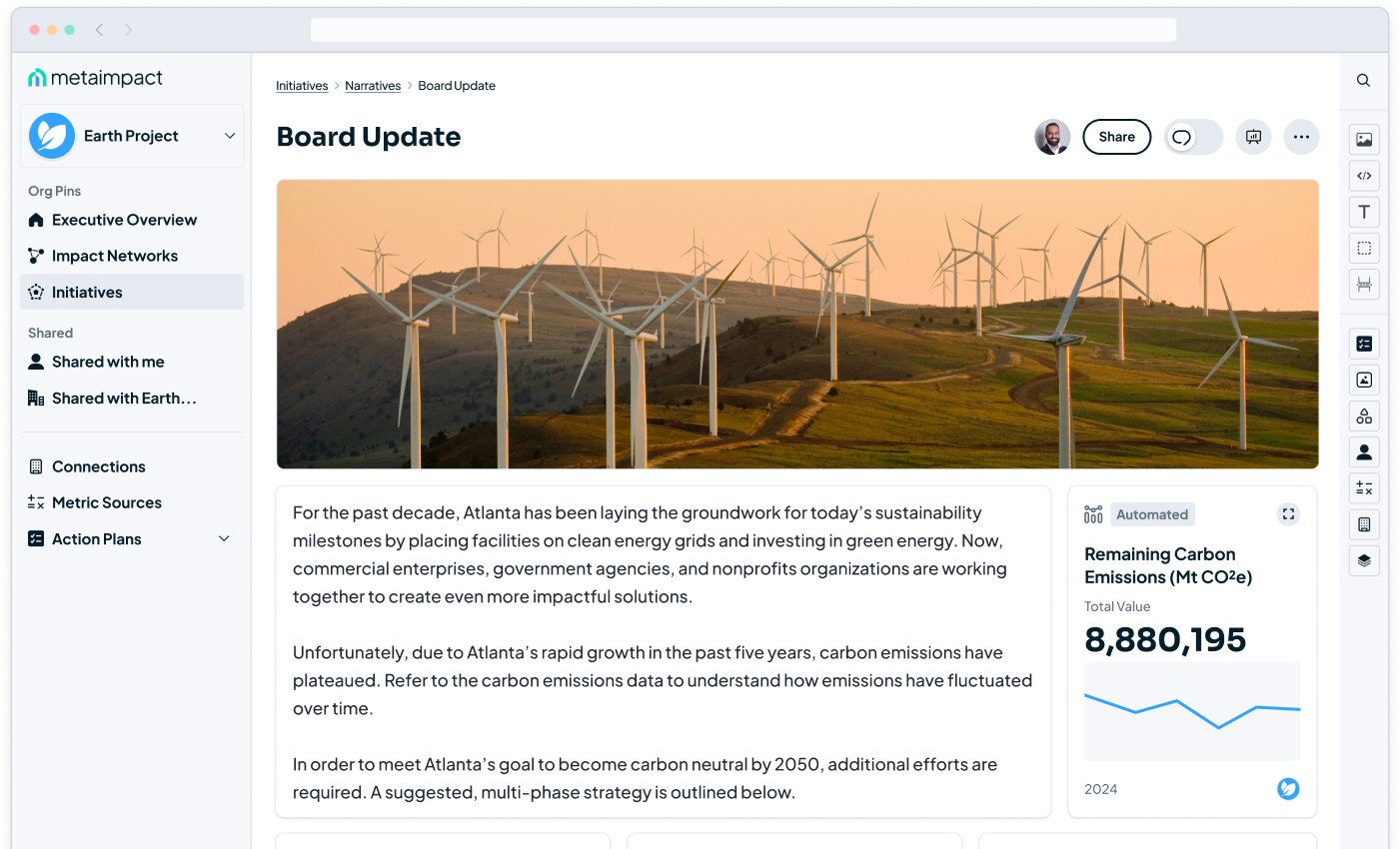Monitoring the Metrics that Matter
Quantifying the impact of strategic initiatives is a critical aspect of success in today's digital age. It’s a task that is becoming increasingly complex, yet more vital than ever before.

Widespread digital transformation has allowed businesses to access an abundance of potentially transformative data, available anytime, anywhere. However, most organizations still struggle to use even a fraction of this data in a productive, impactful way.
Software dashboards and analytics tools provide visibility into critical metrics, but continue to rely on end users to interpret the data and relay gleaned insights to key stakeholders. Unfortunately, there is often a gap in this process and information that should impact business decisions never makes its way to upper management. Even when executives are informed, the narrative surrounding the insight often isn’t compellingly communicated and when an insight’s significance isn’t understood, the data is ignored and never given the chance to drive real change.
In order to use data more effectively, a different approach is needed. Data storytelling is the effective communication of data insights using narratives and visualizations. It’s the act of putting data into context in order to inspire action and influence strategic decisions in real time.
If your team is interested in leveraging data storytelling in your organization, keep reading to learn the best practices for creating a compelling data narrative.
A knowledge gap is the difference between the information you know versus what your audience—typically the executive team—needs to know. When crafting a data narrative, it’s important to close the gap by sharing the information your audience needs to make strategic decisions. In short, not only do you need to present the what, you also need to identify and communicate the why. If, for instance, you share a metric outlining a decline in sales, you also need to share why sales are down in order to give executives the information they need to rectify the situation.
Knowing that the human brain tends to focus on only a small amount of information at once, be strategic about what you communicate in data narratives. Use short and concise explanations to articulate the meaning and impact of an insight and carefully select visual components—metrics, outcomes, graphs, etc—to not overwhelm your audience. Less is more.
Within a data narrative, it’s also important not to use data terminology as the sole mechanism to convey context. Make the data approachable and easy to understand. This is especially helpful if your audience doesn’t have a data background.
Speaking of your audience’s background, it’s paramount for you to have an intimate understanding of who your audience is, what they care about, what information they’ve received beforehand, how they typically process new information, and how familiar they are with data models. This will help you determine the best way to craft the data narrative.
Always be honest with yourself and your audience when reviewing data and creating a narrative. No matter what story the data tells, good or bad, it’s important to craft an accurate depiction. It can be tempting to strategically choose the data that aligns with the narrative you want to tell, but that will ultimately backfire.
It’s not enough to simply provide context to key insights. In order to drive change, a data narrative needs to include a suggested course of action that decision makers can follow. It’s a mutually beneficial system. Upper management gets to adopt a standard, streamlined process for reviewing and actioning key insights and employees benefit from enacting data-driven progress that ensures their success.
A data narrative usually needs to be time-based in order to tell the full story. Oftentimes, executives need to understand and communicate how an initiative or project is progressing within a given timeframe. In that vein, the data narrative should show how a metric or data set has changed over time as well as visualize any patterns that have emerged.
It’s crucial to share data narratives with stakeholders who have the power to enact action and/or change. The purpose of data narratives is to arm change makers with the information they need to make critical decisions quickly and confidently. If you’re sharing narratives with stakeholders who have no authority, you won’t get the results you’re looking for.
Creating a data narrative is often time intensive so it’s helpful to use tools that can streamline the process. Metaimpact gives users the ability to create custom data narratives with copy, images, performance metrics, action plans, and assets in order to provide context to key insights. Using these components, data can be collected and crafted into a comprehensive story arc that communicates the status of an initiative, desired outcome, project, or business relationship with a suggested course of action. Importantly, each component included in a Metaimpact narrative updates in real time to ensure the most current information is depicted. Once a narrative is crafted, it can be shared with executives with the click of a button.
The better organizations communicate insights, the more impactful they become. As data storytelling becomes a more integral part of business strategy, new opportunities will surface, valuable internal conversations will occur, departments will be more aligned, and strategic decisions will be made that make the difference between success and failure. It’s time to embrace data in a new way.

Download the one pager to learn how Metaimpact powers seamless coordination across internal teams, strategic partners, and customers with a secure, collaborative data platform purpose-built to align efforts around shared objectives, consolidate shared data to measure progress, and accelerate delivery of business outcomes.

Download the one pager to learn how Metaimpact enables corporate foundations to collaborate with grant recipients on funded initiatives, give grantees the opportunity to connect, and demonstrate the collective impact of their philanthropic endeavors.

Download the ebook to learn how your organization can go beyond reporting and put a sustainability program in place that drives real progress.

Download the one pager to learn how Metaimpact equips visionary leaders of multi-stakeholder efforts with the tools to define shared goals, drive collective action, and measure meaningful progress.

Quantifying the impact of strategic initiatives is a critical aspect of success in today's digital age. It’s a task that is becoming increasingly complex, yet more vital than ever before.

Last week, Metaimpact gathered with a variety of businesses, government organizations, and NGOs that aspire to drive progress in the state of Indiana. The purpose of the event? To discuss new opportunities that have emerged from the metaverse.

In order to use data more effectively, a different approach is needed—software that enables data storytelling.

As data storytelling becomes a more integral part of business strategy, new opportunities will surface, valuable internal conversations will occur, and departments will become more aligned.

Much of the world associates the metaverse with avatars and immersive VR experiences, which is key for consumers and some business applications, but this new computing paradigm offers a more foundational and transformative opportunity for the business world.

Request a demo to learn how our platform helps organizations define, manage, and measure their most important strategic initiatives.